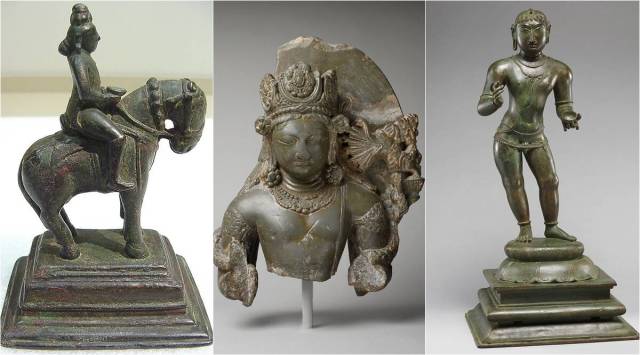Facing widespread criticism and legal scrutiny over several of its catalogued antiquities, that included at least 77 Indian works linked to jailed smuggler Subhash Kapoor, the Metropolitan Museum of Art (Met) in New York has said 16 of those works have been returned to India.
Museum director Max Hollein issued a statement earlier this month that “last month, in light of new provenance information, we returned 16 works to India, including the Celestial Dancer, a sculpture that enraptured visitors for decades.”

This is a reference to the 11th-century sandstone sculpture of an “Apsara” from Madhya Pradesh valued at more than $1 million.
 Kamadeva, the God of Love
Kamadeva, the God of Love
The sculpture was part of the treasure trove at the Met that, according to an investigation in March by The Indian Express in association with the International Consortium of Investigative Journalists (ICIJ) and the UK-based Finance Uncovered, was traced to Kapoor, who is serving a 10-year prison term in Tamil Nadu for smuggling antiquities.
When asked about the Met returning the antiquities, an official in the Ministry of External Affairs (MEA) said legal processes were on and “we can’t comment more than this as of now”. The Archaeological Survey of India (ASI) also said it has no information on the works being returned.
Sources said antiquities that are returned are usually handed over to Indian authorities abroad — missions or High Commissions – after which the MEA informs the ASI, which is the custodian for such repatriated objects. The ASI then sends a team to verify and document the objects, following which a decision is taken about their physical return to India.
 Krishna Subdues the Serpent Kaliya in the Yamuna River: Illustration from a Bhagavata Purana Series
Krishna Subdues the Serpent Kaliya in the Yamuna River: Illustration from a Bhagavata Purana Series
The Met in its statement also announced an “intensive review of its collection” and said it has formed a committee to review its process of acquiring works and artefacts. The Met also said it would hire a manager of provenance research to help with investigating the origin of its assets.
Story continues below this ad
The statement said, “We will broaden, expedite, and intensify our research into all works that came to the Museum from art dealers who have been under investigation. Most of these objects came to the Museum in the period between 1970 and 1990… We will convene thought leaders, advocates, and opinion makers in the area of cultural property in various ways, both within the Museum and outside.”
Announcing an “intensive review of its collection”, the museum said, “We live in a time when the idea of a cosmopolitan, global society is being challenged, and some, more nationalist voices embrace cultural artefacts less as ambassadors of a people but more as evidence of national identity.”
 Parikara (Backplate)
Parikara (Backplate)
On March 22, the Supreme Court of the State of New York had issued a search warrant against the Met, with Justice Felicia A Mennin giving 10 days to the New York Police Department or any agent of the Department of Homeland Security to seize the antiquities and bring them “before the court without unnecessary delay.”
On March 30, the Met issued a statement saying it would “transfer 15 sculptures for return to the government of India, after having learned that the works were illegally removed from India”. It said that “all of the works were sold at one point by Subhash Kapoor, a dealer currently serving a prison sentence in India.”
Story continues below this ad
 The God Danda and the Goddess Niksubha (Attendants of Surya, the Sun God)
The God Danda and the Goddess Niksubha (Attendants of Surya, the Sun God)
Of the 15 items listed in the search warrant, 10 were flagged in The Indian Express report. Among the 15 Indian antiquities listed in the search warrant were, besides the Celestial Dancer, a 1st century BCE Yakshi Terracotta from West Bengal; a bronze sculpture of God Revanta Returning from the Hunt (10th century CE); and a 15th century Parikara (Backplate).
 Panel with Krishna and Gopis
Panel with Krishna and Gopis
The total value of the 15 artefacts was estimated at $1.201 million (nearly Rs 9.87 crore).
Another report in The Indian Express’s investigative series revealed that the Met’s formidable Asia collection included at least 94 artefacts of Jammu and Kashmir origin — 81 sculptures, five paintings, five pages of a manuscript, two Kashmir carpet antiquities and one page of calligraphy — none of which had details in their provenance, or background documents, of when they were moved out and by whom.
 Battle Scene from a Devi Mahatmya
Battle Scene from a Devi Mahatmya
Kapoor, described by the US Department of Homeland Security as “one of the most prolific commodities smugglers in the world”, was arrested in Frankfurt on October 30, 2011, and extradited to India in July 2012.
Story continues below this ad
On November 1, 2022, he was sentenced to 10 years in jail by a court in Tamil Nadu’s Kumbakonam on charges of burglary and illegal export of idols belonging to the Varadharaja Perumal temple in Kanchipuram. He is currently serving his sentence in Trichy jail. Kapoor faces charges in the US as well for smuggling idols and artefacts from Asia.
 Palace Interior
Palace Interior
A complaint filed in July 2019 in a New York court by the Homeland Security Investigation (HSI) stated that the “total value of stolen antiquities known to have been trafficked by Kapoor exceeds $145.71 million”.



 Kamadeva, the God of Love
Kamadeva, the God of Love Krishna Subdues the Serpent Kaliya in the Yamuna River: Illustration from a Bhagavata Purana Series
Krishna Subdues the Serpent Kaliya in the Yamuna River: Illustration from a Bhagavata Purana Series Parikara (Backplate)
Parikara (Backplate) The God Danda and the Goddess Niksubha (Attendants of Surya, the Sun God)
The God Danda and the Goddess Niksubha (Attendants of Surya, the Sun God) Panel with Krishna and Gopis
Panel with Krishna and Gopis Battle Scene from a Devi Mahatmya
Battle Scene from a Devi Mahatmya Palace Interior
Palace Interior






